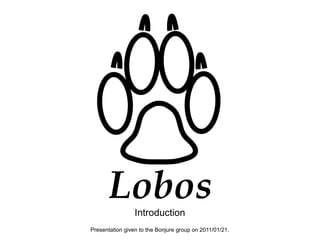
Lobos Introduction
- 1. Lobos Introduction Presentation given to the Bonjure group on 2011/01/21.
- 2. Outline ● Overview & basic concepts ● Past: history and development highlights ● Present: examples, project structure and architecture ● Future: migrations and declarative schema manipulation
- 3. Overview Clojure code SQL Statement(s)* (create CREATE TABLE "users" ( (table :users "name" VARCHAR(100), (integer :id :auto-inc "id" SERIAL, :primary-key) CONSTRAINT "min_length" (varchar :name 100 :unique) CHECK (length("name") > 1), (check :min_length CONSTRAINT "users_unique_name" (> :length/name 1)))) UNIQUE ("name"), CONSTRAINT "users_primary_key_id" PRIMARY KEY ("id")) Note that the syntax is partially inspired by ActiveRecord::Migration *This example use the PostgreSQL backend.
- 4. Basic Concepts ● Abstract Schema Definition: Used internally to represent a database schema. ● Action: Functions executing imperative SQL statements. ● AST: Intermediate database-agnostic representation of SQL statements.
- 5. Past
- 6. History ● Lobos is based on the original ClojureQL project which was based on SchemeQL. ● It's a complete rewrite of the DDL part. ● Lobos is less than a month old and a one-man effort for now.
- 7. Development Highlights ● Uses most Clojure features and best practices. ● Namespace structure makes the project very modular. ● Bugs in Clojure code can be hard to diagnose, beware of laziness!
- 8. Present
- 9. Examples (use 'lobos.connectivity) (def pg {:classname "org.postgresql.Driver" :subprotocol "postgresql" :user "test" :password "test123" :subname "//localhost:5432/test"}) (open-global pg) (close-global) || (open-global :pg pg) (close-global :pg) You can specify a connection map (or global connection name) as the first argument of an action or use the global default connection.
- 10. Examples All elements are constructed using functions or macros that yield Clojure data structures and thus are composable. Here we define some helpers: (use 'lobos.schema) (defn surrogate-key [table] (integer table :id :auto-inc :primary-key)) (defmacro tabl [name & elements] `(-> (table ~name (surrogate-key)) ~@elements)) (defn refer-to [table ptable] (let [cname (-> (->> ptable name butlast (apply str)) (str "_id") keyword)] (integer table cname [:refer ptable :id :on-delete :set-null])))
- 11. Examples With the previously defined custom functions and macros we can define a more complex schema with less code... (use 'lobos.core) (defschema sample-schema :lobos (tabl :users (varchar :name 100 :unique) (check :name (> :length/name 1))) (tabl :posts (varchar :title 200 :unique) (text :content) (refer-to :users)) (tabl :comments (text :content) (refer-to :users) (refer-to :posts)))
- 12. Examples Schemas created with defschema are functions returning an abstract schema! (create-schema sample-schema) (set-default-schema sample-schema) (drop (table :posts) :cascade) (drop-schema sample-schema :cascade) The cascade behavior works even in SQL Server which doesn't support that feature! Dropping a schema created with defschema makes the defined function return nil, so just pretend we didn't evaled that line! Warning: all uses of exclamation points in this slide are completely superfluous!
- 13. Examples (alter :add (table :users (text :bio))) (alter :add (table :users (text :location) (text :occupation))) (alter :add (table :posts (check :content_limit (< :length/content 1337)))) (alter :modify (table :users (column :location [:default "somewhere"]))) (alter :drop (table :users (column :occupation))) (alter :rename (table :users (column :location :to :origin)))
- 14. Any questions yet? Do we need a break?
- 15. Project Structure ● Frontend lobos.core lobos.schema lobos.connectivity ● Backend lobos.compiler lobos.ast lobos.backends.* ● Analyzer lobos.metadata lobos.analyzer
- 16. Project Structure connectivity core * analyzer schema utils metadata ast compiler backends
- 17. Architecture ● Actions yield Abstract Schema Definitions ● Schema protocols build a AST(s) from ASDs ● The compiler (compile multi-method) generates the appropriate SQL statements from an AST. ● The analyzer constructs an abstract schema ASD from a real schema.
- 18. Architecture (defrecord Table [name columns constraints options] Alterable Creatable Dropable (build-alter-statement [this action db-spec] (let [elements (map #(build-definition (second %) db-spec) (concat columns constraints))] (for [element elements] (AlterTableStatement. db-spec name action element)))) (build-create-statement [this db-spec] (CreateTableStatement. db-spec name (map #(build-definition (second %) db-spec) (concat columns constraints)))) (build-drop-statement [this behavior db-spec] (DropStatement. db-spec :table name behavior)))
- 19. Architecture (def backends-hierarchy (atom (-> (make-hierarchy) (derive :h2 ::standard) (derive :mysql ::standard) (derive :postgresql ::standard) (derive :sqlite ::standard) (derive :sqlserver ::standard)))) (defmulti compile (fn [o] [(-> o :db-spec :subprotocol (or ::standard) keyword) (type o)]) :hierarchy backends-hierarchy) ... (defmethod compile [::standard AutoIncClause] [_] "GENERATED ALWAYS AS IDENTITY") ... (defmethod compile [:mysql AutoIncClause] [_] "AUTO_INCREMENT")
- 20. Future
- 21. Migrations Objectives: ● Could be written manually, like in ActiveRecord::Migration ● Could be automatically generated when actions are entered at the REPL ● Also automatically generated when declaratively changing a schema definition (see next slide)
- 22. Declarative Schema Manipulation Say we are working on a database built from the following schema: (defschema sample-schema :lobos (table :users (varchar :name 100 :unique) (check :name (> :length/name 1))) ... Instead of imperatively issuing alter statements, wouldn't it be great to just change it? (defschema sample-schema :lobos (table :users (varchar :name 100 :unique) (text :bio) (check :name (> :length/name 1))) ...
- 23. I need your help! Visit the project's github page: https://github.com/budu/lobos Any questions suggestions, comments or insults?
- 24. Links Website: http://budu.github.com/lobos/ Code Repository: https://github.com/budu/lobos Issue Tracker: https://github.com/budu/lobos/issues Wiki: https://github.com/budu/lobos/wiki
- 25. Acknowledgments Thanks (in alphabetical order) to: ● James Reeves (for Hiccup) ● Lau B. Jensen (for the old and new ClojureQLs) ● Meikel Brandmeyer (for working with me on the old ClojureQL) ● Michael Fogus (for Marginalia and "The Joy of Clojure" book) ● Phil Hagelberg (for Leiningen) ● Rich Hickey (for Clojure) ● Stephen C. Gilardi (for clojure.contrib.sql) Also thanks to all Clojure contributors and to its fantastic community!
- 26. The End!
